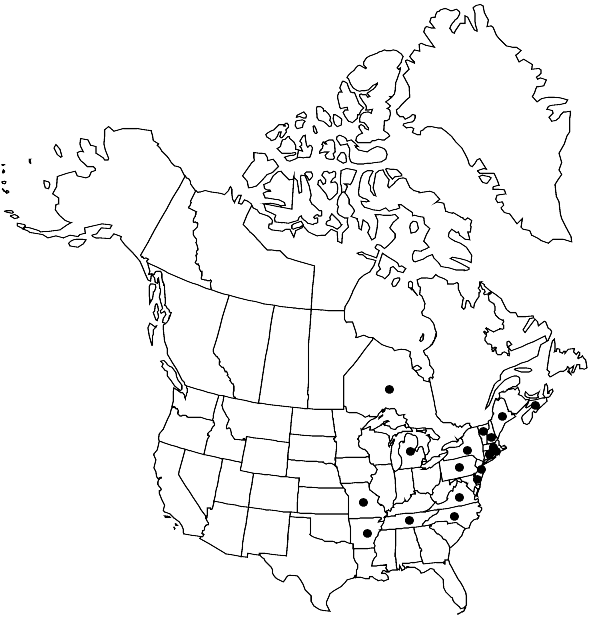Difference between revisions of "Grimmia olneyi"
in W. S. Sullivant and C. L. Lesquereux, Musc. Bor.-Amer., 141. 1857,.
FNA>Volume Importer |
FNA>Volume Importer |
(No difference)
| |
Revision as of 21:52, 16 December 2019
Plants in flat patches, dark green to brownish black. Stems 1–2 cm. Leaves narrowly ovate-lanceolate from an ovate base, 2–3 × 0.4–0.8 mm, both margins incurved, intermarginal bands absent, awn 0.1–0.5 mm, not decurrent, acute, costa narrow proximally; basal juxtacostal laminal cells quadrate to short-rectangular, straight, thick lateral walls, green; basal marginal laminal cells quadrate, straight, thick transverse and thin lateral walls, green, hyaline; medial laminal cells quadrate, slightly thick-walled; distal laminal cells 2–4 stratose, rounded, thick-walled. Perichaetial leaves not enlarged. Seta sigmoid, 3–4 mm. Capsule occasionally present, exserted, brown, oblong-ovoid, exothecial cells short-rectangular, thin-walled, stomata present, annulus of 2–3 rows of rectangular, thick-walled cells, operculum long-rostrate, peristome perforate in distal half, split in distal half. Calyptra cucullate.
Habitat: Cracks and exposed faces of dry to periodically wet, acidic or calcareous rocks, commonly along streams or splash zones of lake shores
Elevation: low to moderate elevations (20-600 m)
Distribution

N.S., Ont., Ark., Conn., Del., Maine, Mass., Mich., Mo., N.H., N.J., N.Y., N.C., Pa., R.I., Tenn., Vt., Va.
Discussion
Grimmia olneyi is endemic to eastern North America, with its center of distribution along the Appalachians from the New England states to North Carolina and eastern Tennessee. A disjunct population occurs on the Ozark Plateau of Missouri and Arkansas. Unlike G. unicolor, G. olneyi is tolerant of calcareous rocks and is able to occupy drier sites. Because of its sigmoid seta and somewhat wrinkled capsule, it is usually placed in subg. Rhabdogrimmia. However, the seta of G. olneyi is usually only somewhat sigmoid and is rarely arcuate. Further, its capsules only become wrinkled when dry, whereas the members of subg. Rhabdogrimmia typically have plicate capsules whether dry or turgid. In fact, specimens of G. olneyi are most commonly misidentified as either G. ovalis or G. laevigata, in subg. Litoneuron. The seta and capsule of G. olneyi are at the extremes of both subgenera. However, the general habit of the plants and their leaf structure suggests a close relationship with G. ovalis and G. unicolor.
Grimmia olneyi and G. laevigata have broadly overlapping distributions in eastern North America, where many specimens of G. olneyi have been misidentified as G. laevigata. Typical specimens of G. olneyi are readily separated from G. laevigata. However, some leaves on a stem of G. laevigata may have defined ovate bases with narrowly decurrent awns. These specimens will resemble G. olneyi. However, the costa of G. olneyi is always narrow at the base, while that of G. laevigata becomes broad at the base, occupying up to 1/3 of the lamina, and the costa grades gradually into the basal laminal cells. Furthermore, G. olneyi has quadrate to short-rectangular basal juxtacostal cells, while those of G. laevigata are elongate, almost resembling costal cells. Grimmia olneyi most closely resembles G. ovalis. Both have ovate lanceolate leaves from an ovate base, with a narrow distal lamina that is channelled, ending in a narrowly attached, long and toothed awn. The costa is narrow proximally in both species. However, they are otherwise quite distinct. Aside from the sigmoid seta and slightly wrinkled dry capsule of G. olneyi, its basal juxtacostal laminal cells are shorter and straighter than those of G. ovalis and its basal marginal cells are quadrate while those of G. ovalis are mostly rectangular. Geographical distribution has also been used to separate these species; H. A. Crum and L. E. Anderson (1981) rejected all reports of G. ovalis from eastern North America. However, we have seen a number of specimens of it from there and conclude that geography alone is not a reliable basis on which to differentiate these species.
Selected References
None.